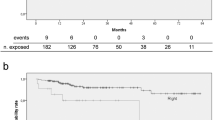Abstract
Cancer patients usually require repeated venous punctures for chemotherapy or other reasons. Therefore, totally implantable venous access port (TIVAP) systems have been helpful for patients with difficult vascular access. The purpose of this study was to evaluate the safety and feasibility of the totally implantable venous access port (TIVAP) implanted using a supraclavicular approach. After identification of the anatomical landmarks (clavicular head of the sternocleidomastoid muscle) for a supraclavicular approach, the patient was anesthetized with 1% lidocaine. After puncturing the central vein with an 18-G needle, the Seldinger catheterization procedure was performed. Between March 2017 and February 2018, 89 totally implantable venous access ports (TIVAPs) were inserted in 89 consecutive patients (32 men and 57 women) with a mean age of 57.5 years (range, 19–89 years) through a supraclavicular approach. Successful totally implantable venous access port (TIVAP) implantation was achieved in 96.6% (86 of 89) of patients. In 2 patients, port catheter placement failed despite successful vascular puncture because a wire could not be passed after cannulation of the blood vessel. The other case of failed placement was due to development of pneumothorax during vascular puncture. Venous port-related complications such as bleeding, infection, thrombosis, malfunction, or catheter fracture did not occur within 2 postoperative weeks. Totally implantable venous access port (TIVAP) implantation through the supraclavicular approach can be performed safely and feasibly for oncologic patients with difficult central or peripheral venous access.
Similar content being viewed by others
References
Niederhuber JE, Ensminger W, Gyves JW, Liepman M, Doan K, Cozzi E (1982) Totally implanted venous and arterial access system to replace external catheters in cancer treatment. Surgery 92(4):706–712
Vescia S, Baumgärtner AK, Jacobs VR, Kiechle-Bahat M, Rody A, Loibl S, Harbeck N (2008) Management of venous port systems in oncology: a review of current evidence. Ann Oncol 19(1):9–15
Bannon MP, Heller SF, Rivera M (2011) Anatomic considerations for central venous cannulation. Risk Manag Healthc Policy 4:27–39
McGee DC, Gould MK (2003) Preventing complications of central venous catheterization. N Engl J Med 348(12):1123–1133
Yoffa D (1965) Supraclavicular subclavian venepuncture and catheterisation. Lancet 2(7413):614–617
Bertini P, Frediani M (2013) Ultrasound guided supraclavicular central vein cannulation in adults: a technical report. J Vasc Access 14(1):89–93
Patrick SP, Tijunelis MA, Johnson S, Herbert ME (2009) Supraclavicular subclavian vein catheterization: the forgotten central line. West J Emerg Med 10(2):110–114
Brahos GJ (1977) Central venous catheterization via the supraclavicular approach. J Trauma 17(11):872–877
Gallieni M, Pittiruti M, Biffi R (2008) Vascular access in oncology patients. CA Cancer J Clin 58(6):323–346
Maki DG, Kluger DM, Crnich CJ (2006) The risk of bloodstream infection in adults with different intravascular devices: a systematic review of 200 published prospective studies. Mayo Clin Proc 81(9):1159–1171
Walser EM (2012) Venous access ports: indications, implantation technique, follow-up, and complications. Cardiovasc Intervent Radiol 35(4):751–764
Wu S, Huang J, Jiang Z, Huang Z, Ouyang H, Deng L, Lin W, Guo J, Zeng W (2016) Internal jugular vein versus subclavian vein as the percutaneous insertion site for totally implantable venous access devices: a meta-analysis of comparative studies. BMC Cancer 16(1):747
Bennett JD, Papadouris D, Rankin RN, McGloughlin RF, Kribs S, Kozak RI, Garvin G, Elliott J (1997) Percutaneous inferior vena caval approach for long-term central venous access. J Vasc Interv Radiol 8(5):851–855
Goltz JP, Scholl A, Ritter CO, Wittenberg G, Hahn D, Kickuth R (2010) Peripherally placed totally implantable venous-access port systems of the forearm: clinical experience in 763 consecutive patients. Cardiovasc Intervent Radiol 33(6):1159–1167
Goltz JP, Janssen H, Petritsch B, Kickuth R (2014) Femoral placement of totally implantable venous power ports as an alternative implantation site for patients with central vein occlusions. Support Care Cancer 22(2):383–387
Dronen S, Thompson B, Nowak R, Tomlanovich M (1982) Subclavian vein catheterization during cardiopulmonary resuscitation. A prospective comparison of the supraclavicular and infraclavicular percutaneous approaches. Jama 247(23):3227–3230
Sterner S, Plummer DW, Clinton J, Ruiz E (1986) A comparison of the supraclavicular approach and the infraclavicular approach for subclavian vein catheterization. Ann Emerg Med 15(4):421–424
Kocum A, Sener M, Calıskan E, Bozdogan N, Atalay H, Aribogan A (2011) An alternative central venous route for cardiac surgery: supraclavicular subclavian vein catheterization. J Cardiothorac Vasc Anesth 25(6):1018–1023
Mallin M, Louis H, Madsen T (2010) A novel technique for ultrasound-guided supraclavicular subclavian cannulation. Am J Emerg Med 28(8):966–969
Breschan C, Platzer M, Jost R, Stettner H, Beyer AS, Feigl G, Likar R (2011) Consecutive, prospective case series of a new method for ultrasound-guided supraclavicular approach to the brachiocephalic vein in children. Br J Anaesth 106(5):732–737
Rhondali O, Attof R, Combet S, Chassard D, de Queiroz SM (2011) Ultrasound-guided subclavian vein cannulation in infants: supraclavicular approach. Paediatr Anaesth 21(11):1136–1141
Breschan C, Platzer M, Jost R, Stettner H, Feigl G, Likar R (2012) Ultrasound-guided supraclavicular cannulation of the brachiocephalic vein in infants: a retrospective analysis of a case series. Paediatr Anaesth 22(11):1062–1067
Yamauchi M, Sasaki H, Yoshida T, Niiya T, Mizuno E, Narimatsu E, Yamakage M (2012) Ultrasound-guided supraclavicular central venous catheterization in patients with malignant hematologic diseases. J Anesth 26(5):775–778
Breschan C, Graf G, Jost R, Stettner H, Feigl G, Goessler A, Neuwersch S, Koestenberger M, Likar R (2015) Ultrasound-guided supraclavicular cannulation of the right brachiocephalic vein in small infants: a consecutive, prospective case series. Paediatr Anaesth 25(9):943–949
Muhm M, Sunder-Plassmann G, Apsner R, Kritzinger M, Hiesmayr M, Druml W (1997) Supraclavicular approach to the subclavian/innominate vein for large-bore central venous catheters. Am J Kidney Dis 30(6):802–808
Cunningham SC, Gallmeier E (2007) Supraclavicular approach for central venous catheterization: "safer, simpler, speedier". J Am Coll Surg 205(3):514–516 author reply 516-517
Sousa B, Furlanetto J, Hutka M, Gouveia P, Wuerstlein R, Mariz JM, Pinto D, Cardoso F, Guidelines Committee ESMO (2015) Central venous access in oncology: ESMO clinical practice guidelines. Ann Oncol 26(Suppl 5):v152–v168
Author information
Authors and Affiliations
Corresponding author
Ethics declarations
This study was approved by our institutional review board. Informed consent from individual patients was waived because this study was conducted through analyses of historical patient’s records.
Conflict of Interest
The authors declare that they have no conflict of interest.
Additional information
Publisher’s Note
Springer Nature remains neutral with regard to jurisdictional claims in published maps and institutional affiliations.
Rights and permissions
About this article
Cite this article
Kang, DY., Oh, T.Y. Early Results of Totally Implantable Central Venous Access Port Insertion Through a Supraclavicular Approach. Indian J Surg 83, 289–292 (2021). https://doi.org/10.1007/s12262-020-02394-6
Received:
Accepted:
Published:
Issue Date:
DOI: https://doi.org/10.1007/s12262-020-02394-6




